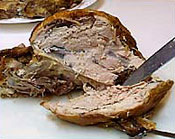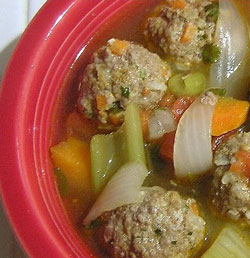 It took me half my life to realize that when Guadalupe Contreras
says “Gadaymee”, she means to say, “Goddamn it”. I thought for years
that she had been referring to my sister, whose name is Amy, with a
level of stifled frustration that I found hard to account for. I told a
Spanish-speaking friend about this misunderstanding a while back, and
he in turn informed me that my Spanish pronunciation of “I’m scared”
(tengo miedo) sounds a lot like “I have shit” (tengo mierda). I relayed
this conversation to Lupe. She claimed to disagree.
It took me half my life to realize that when Guadalupe Contreras
says “Gadaymee”, she means to say, “Goddamn it”. I thought for years
that she had been referring to my sister, whose name is Amy, with a
level of stifled frustration that I found hard to account for. I told a
Spanish-speaking friend about this misunderstanding a while back, and
he in turn informed me that my Spanish pronunciation of “I’m scared”
(tengo miedo) sounds a lot like “I have shit” (tengo mierda). I relayed
this conversation to Lupe. She claimed to disagree.
There are some things whose very greatness lies in the fact that they can’t be translated, or imitated at all, without some diminishment of their essence. This is often the case with poetry in translation, but I believe the phenomenon extends to other things, like bed-head, or fans of the Boston Red Sox. We read translations anyway, of course, secure that what we find in them will still be more than enough, that the meaning of a word, a palabra, can transcend language. Recipes can be like this for those who collect them, more than a list of ingredients, or a formula for the cook. Cooking from a recipe, or merely writing it down, is itself an act of translation, and so the closer that recipe comes to the source, the better. I feel this way about Albondigas soup, which is why my sister and I decided to take a lesson in preparing it from the true master, a woman who takes her own sources seriously, kneading raw beef like bread dough, and starting her meat stock with a pile of scary, dull white bones: Guadalupe Contreras.
 It took me half my life to realize that when Guadalupe Contreras says “Gadaymee”, she means to say, “Goddamn it”. I thought for years that she had been referring to my sister, whose name is Amy, with a level of stifled frustration that I found hard to account for. I told a Spanish-speaking friend about this misunderstanding a while back, and he in turn informed me that my Spanish pronunciation of “I’m scared” (tengo miedo) sounds a lot like “I have shit” (tengo mierda). I relayed this conversation to Lupe. She claimed to disagree.
It took me half my life to realize that when Guadalupe Contreras says “Gadaymee”, she means to say, “Goddamn it”. I thought for years that she had been referring to my sister, whose name is Amy, with a level of stifled frustration that I found hard to account for. I told a Spanish-speaking friend about this misunderstanding a while back, and he in turn informed me that my Spanish pronunciation of “I’m scared” (tengo miedo) sounds a lot like “I have shit” (tengo mierda). I relayed this conversation to Lupe. She claimed to disagree.
There are some things whose very greatness lies in the fact that they can’t be translated, or imitated at all, without some diminishment of their essence. This is often the case with poetry in translation, but I believe the phenomenon extends to other things, like bed-head, or fans of the Boston Red Sox. We read translations anyway, of course, secure that what we find in them will still be more than enough, that the meaning of a word, a palabra, can transcend language. Recipes can be like this for those who collect them, more than a list of ingredients, or a formula for the cook. Cooking from a recipe, or merely writing it down, is itself an act of translation, and so the closer that recipe comes to the source, the better. I feel this way about Albondigas soup, which is why my sister and I decided to take a lesson in preparing it from the true master, a woman who takes her own sources seriously, kneading raw beef like bread dough, and starting her meat stock with a pile of scary, dull white bones: Guadalupe Contreras.
 As we picked Lupe up for our lesson, I asked Lupe if she preferred her local grocery store. She shrugged indifferently, although once at the Ralph’s in Santa Monica, she proceeded to chide an employee in Spanish about the price of onions, and made me scrub my hands – twice - with a Clorox wipe. (“Microbos” she said, nudging at the shopping cart with a covered-up elbow.) She did lighten up, finally, when Christmas decorations in the freezer section prompted her to recount a favorite story: the holiday years ago when, after having carved all the meat from a turkey and secretly set it aside, she presented the intact carcass to an eight year old Amy and told her, so sorry, but we’d already finished it all. Lupe, after two decades, still finds this story hilarious, and my sister, after all that time, still seems a little pissed. Stories like this are what make our relationship to Lupe seem untranslatable to English: homie comes close but lacks the significant maternal aspect; nor does it convey what a pain in the ass she is. Lupe puts it more broadly, asserting that we are “familia”, and then proves her point by telling me that I look beautiful and disapproving of my haircut in the very same breath.
As we picked Lupe up for our lesson, I asked Lupe if she preferred her local grocery store. She shrugged indifferently, although once at the Ralph’s in Santa Monica, she proceeded to chide an employee in Spanish about the price of onions, and made me scrub my hands – twice - with a Clorox wipe. (“Microbos” she said, nudging at the shopping cart with a covered-up elbow.) She did lighten up, finally, when Christmas decorations in the freezer section prompted her to recount a favorite story: the holiday years ago when, after having carved all the meat from a turkey and secretly set it aside, she presented the intact carcass to an eight year old Amy and told her, so sorry, but we’d already finished it all. Lupe, after two decades, still finds this story hilarious, and my sister, after all that time, still seems a little pissed. Stories like this are what make our relationship to Lupe seem untranslatable to English: homie comes close but lacks the significant maternal aspect; nor does it convey what a pain in the ass she is. Lupe puts it more broadly, asserting that we are “familia”, and then proves her point by telling me that I look beautiful and disapproving of my haircut in the very same breath.
 Back home in my kitchen, Amy and I were told to pull up chairs, as if at a lecture. Any note I scribbled about the proceedings was instantly dismissed as ridiculous, however, since the only rule for albondigas is to make them taste como ti te gustas. If that means chopping onions while you weep, or lifting a seventy pound cast-iron pot even if, like Lupe, you’re seventy years old, you “gadaymee” better do it. There are no short cuts, no beginner version of Albondigas as far as Lupe is concerned; part of its authenticity to her lies in the act of doing it. In fact, the only thing that Lupe allowed us to do was chop the carrots. (“Why not the zucchini?” Amy asked. Lupe ignored her.) In the end, she seemed satisfied that we now had the experience necessary to cook the soup ourselves, but proud to have it taste just as we remembered it; that is to say, like hers. She is, after all, well versed in the language of cooking albondigas, while we were just beginning to conjugate the verb.
Back home in my kitchen, Amy and I were told to pull up chairs, as if at a lecture. Any note I scribbled about the proceedings was instantly dismissed as ridiculous, however, since the only rule for albondigas is to make them taste como ti te gustas. If that means chopping onions while you weep, or lifting a seventy pound cast-iron pot even if, like Lupe, you’re seventy years old, you “gadaymee” better do it. There are no short cuts, no beginner version of Albondigas as far as Lupe is concerned; part of its authenticity to her lies in the act of doing it. In fact, the only thing that Lupe allowed us to do was chop the carrots. (“Why not the zucchini?” Amy asked. Lupe ignored her.) In the end, she seemed satisfied that we now had the experience necessary to cook the soup ourselves, but proud to have it taste just as we remembered it; that is to say, like hers. She is, after all, well versed in the language of cooking albondigas, while we were just beginning to conjugate the verb.
 The culinary identity of Americans is a famously complex one, and having returned to Southern California after a twelve-year absence, I am reminded that the tastes of Angelenos run particularly far and wide. For those of us who grew up here – raised to pronounce Spanish street names with the proper inflection, attending as many quinceñeras as sweet sixteens – the flavor of Albondigas is as immutable and transporting as apple pie. Skimming the fat after the soup’s initial cooking hour – a veritable crust of lard that you crack through the top of like a crème brulee – can be as ceremonious as carving a turkey. And the flavors. . .a spoonful of stewed carrots and zucchini, suffused with the peppy combination of cilantro and mint. . .then the meatballs themselves, impossibly soft and rice-studded, and the way they melt away a bit into the broth, enriching everything else with a thick, soothing texture. I can think of no other soup so elemental to me, so nourishing and desirable in and of itself.
The culinary identity of Americans is a famously complex one, and having returned to Southern California after a twelve-year absence, I am reminded that the tastes of Angelenos run particularly far and wide. For those of us who grew up here – raised to pronounce Spanish street names with the proper inflection, attending as many quinceñeras as sweet sixteens – the flavor of Albondigas is as immutable and transporting as apple pie. Skimming the fat after the soup’s initial cooking hour – a veritable crust of lard that you crack through the top of like a crème brulee – can be as ceremonious as carving a turkey. And the flavors. . .a spoonful of stewed carrots and zucchini, suffused with the peppy combination of cilantro and mint. . .then the meatballs themselves, impossibly soft and rice-studded, and the way they melt away a bit into the broth, enriching everything else with a thick, soothing texture. I can think of no other soup so elemental to me, so nourishing and desirable in and of itself.
 I had some initial concerns about sharing Guadalupe’s Albondigas recipe with the public at large. What to include? What to leave out? Take the meatball. There are countless ways to form a meatball, but Lupe’s pitcher approach, throwing the meat into your hand like a baseball into a glove, is the only one that matters. But what about la conversación? During that afternoon, as stripped cilantro sailed into the pot, my sister and I found that Lupe’s favored topics were the same as ever: the tragic thinness of our hair, natural disasters, her favorite scenes from Something About Mary, and why we should never open our door, even to what sounds like our dying father, after ten o’clock at night. As much as I want to, I can’t include these things in the recipe: the memories and historias that accompany a food are what you will have to provide yourself.
I had some initial concerns about sharing Guadalupe’s Albondigas recipe with the public at large. What to include? What to leave out? Take the meatball. There are countless ways to form a meatball, but Lupe’s pitcher approach, throwing the meat into your hand like a baseball into a glove, is the only one that matters. But what about la conversación? During that afternoon, as stripped cilantro sailed into the pot, my sister and I found that Lupe’s favored topics were the same as ever: the tragic thinness of our hair, natural disasters, her favorite scenes from Something About Mary, and why we should never open our door, even to what sounds like our dying father, after ten o’clock at night. As much as I want to, I can’t include these things in the recipe: the memories and historias that accompany a food are what you will have to provide yourself.
Lupe, for her part, seemed thrilled when I asked if I might share her recipe for Albondigas, and insisted that I claim it as my own. “Es tuya,” she said. Es la Verdad. It is mine now, and while attempts to replicate it will no doubt taste delicious, they’ll never be as good as hers…Gadaymee.
Lupe’s Albondigas
(Serves 12, prepare one day in advance.)
Begin your sopa by simmering three or four marrowbones in a gigantic pot filled halfway with water. Skim foam, then cover. Skim again as necessary.
Combine two packages of ground beef and one package of ground pork. Add one handful of salt, five eggs, once cup of uncooked white rice, one bunch of chopped mint, a diced white onion, and five or six diced Roma tomatoes. Combine with another handful of salt and knead until uniform. Set aside.
Back at the sopa, add a half bunch of cilantro, stems and all.
In a new, slightly smaller pot, add a handful of stripped cilantro (just leaves), two chopped Roma tomatoes, two big cans of diced tomatoes, a thickly diced onion, one large jalepeño cut into rounds, two large zucchinis cut into rounds, and couple glugs of canola oil. Put on the burner and stir.
Back again at your sopa, skim the foam and throw in a handful of salt. Add a half bag of baby carrots, coarsely chopped.
Once the smaller, veggie filled pot has reached a simmer, add it to the gigantic broth and carrot pot. You may add more salt or water if necessary.
Make your meatballs using the pitcher approach. Pinch off a hearty chunk of meatball mixture and throw it into your palm like a baseball into a glove. It may take a few tosses to get them globular. If bits of mint or tomato poke out, push these back in with your finger: the meatballs should be small and compact. Add your meatballs to the pot as you go.
Cook albondigas at a steady simmer for one hour, partially covered. Cool completely, remove bones and refrigerate overnight. Three hours before you plan on serving the Albondigas the next day, remove the crust of fat that will have formed, then reheat slowly. Serve with white corn tortillas.
After 12 years away from her home turf of Southern California, Agatha French returned to Los Angeles from Boston this fall. She, and her boyfriend Ryan, are very much looking forward to the year round fruit.

